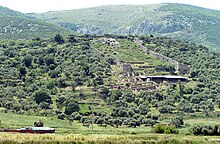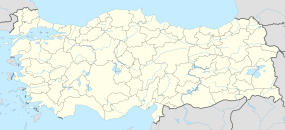Metropolis (Anatolia): Difference between revisions
KolbertBot (talk | contribs) m Bot: HTTP→HTTPS (v477) |
Rescuing 2 sources and tagging 0 as dead. #IABot (v1.6.1) (Balon Greyjoy) |
||
| Line 82: | Line 82: | ||
== External links == |
== External links == |
||
{{commons category}} |
{{commons category}} |
||
*[http://www.metropoliskazilari.com/en/index.asp The Official Site of Metropolis Excavations] |
*[https://web.archive.org/web/20100826063510/http://www.metropoliskazilari.com/en/index.asp The Official Site of Metropolis Excavations] |
||
*[http://www.khm.uio.no/forskning/prosjekter/metropolis/ Kulturhistorisk Museum Universitetet i Oslo Metropolis Page] |
*[https://web.archive.org/web/20110716055953/http://www.khm.uio.no/forskning/prosjekter/metropolis/ Kulturhistorisk Museum Universitetet i Oslo Metropolis Page] |
||
*[http://www.facebook.com/#!/group.php?gid=8465888732&ref=ts Facebook Group of Metropolis Excavations] |
*[http://www.facebook.com/#!/group.php?gid=8465888732&ref=ts Facebook Group of Metropolis Excavations] |
||
Revision as of 05:04, 11 January 2018
 The city's ruins as seen from the east. | |
| Location | Yeniköy, Izmir Province, Turkey |
|---|---|
| Region | Ionia |
| Coordinates | 38°07′30″N 27°19′21″E / 38.12500°N 27.32250°E |
| Type | Settlement |
The classical city of Metropolis is situated in western Turkey near Yeniköy village in Torbali municipality - approximately 40 km SE of Izmir. Occupation at the site goes back to the Neolithic period. The Hittite period is also attested (needed reference).
Classical, Hellenistic, Roman, Byzantine and Ottoman periods are well represented at the site.
History
The earliest known settlement at the site is from the Neolithic showing evidence of contact and influence with the Troy I littoral culture (needed reference).
An as yet undeciphered seal written in hieroglyphics similar to those of the Hittites has been found in the acropolis of Metropolis. The Hittite kingdom of Arzawa had its capital Apasas (later Ephesus) some 30 km to the south west. During the Hittite period, the city was known as Puranda.[1]
The Mycenaean remains are also found.[2] Bademgedigi Tepe is the archaeological site in the area with large amounts of local Mycenaean pottery, ranging from the 14th to 12th century BC, and later.[3][4]
A Mycenaean-age representation of a ship on a vase from Bademgediği Tepe is an important find that casts light on the development of ship technology and iconography on ceramic vessels.[5]
Metropolis was a part of the Hellenistic kingdom of Pergamum and during this period the city reached a zenith of cultural and economic life. A temple dedicated to the war god Ares, one of only two known such temples, has been located here.

What is visible today is primarily a Hellenistic city heavily Romanised, and with Byzantine remains laid across it – a church to the east of the city, and fortification walls laid across city that connect to the Hellenistic defenses on the Acropolis.
Excavations
The city was first investigated through archaeological field work from 1972 by Professor Recep Meriç from the Dokuz Eylül University, Izmir. Metropolis has been excavated since 1989.[6]
Notes
- ^ Hawkins, J. D. 2009. The Arzawa letters in recent perspective. British Museum Studies in Ancient Egypt and Sudan 14:73–83
- ^ Meriç, R., Mountjoy, P., “Three Mycenaean Vases from Ionia”, Istanbuler Mitteilungen, 51, 2001, s. 133-137
- ^ Jorrit Kelder (2006), Mycenaeans in Western Anatolia academia.edu
- ^ Meriç, R., Mountjoy, P. (2002), “Mycenaean Pottery from Bademgedigi Tepe (Puranda) in Ionia: A Preliminary Report.” Istanbul Mitteilungen 52:79–98
- ^ P.A. Mountjoy, A Bronze Age Ship from Ashkelon with Particular Reference to the Bronze Age Ship from Bademgediği Tepe. American Journal of Archaeology Vol. 115, No. 3 (July 2011), pp. 483–488 doi:10.3764/aja.115.3.0483
- ^ Meriç, R., Metropolis, City of the Mother Goddess, İstanbul, 2003
Bibliography
Books
- Aybek, S., Metropolis İonia I: Heykel, Metropolis'de Hellenistik ve Roma Dönemi Heykeltıraşlığı, İstanbul, 2009.
- Aybek, S., Ekin Meriç, A., Öz, A. K., Metropolis: A Mother Goddess City in Ionia, İstanbul, 2009.
- Aybek, S., Ekin Meriç, A., Öz, A. K., Metropolis: İonia'da Bir Ana Tanrıça Kenti, İstanbul, 2009.
- Meriç, R., Metropolis, City of the Mother Goddess, İstanbul, 2003.
- Meriç, R., Metropolis, Ana Tanrıça Kenti, İstanbul, 2003.
- Meriç, R., Späthellenistisch-römische Keramik und Kleinfunde aus einem Scachtbrunnen am Staatsmarkt in Ephesos, Wien, 2002.
- Meriç, R., Metropolis Kazılarının İlk 5 Yılı, İstanbul, 1996.
- Meriç, R., Metropolis, İstanbul, 1992.
- Meriç, R., Metropolis in Ionien: Ergebnisse einer Survey-Unternehmung in den Jahren 1972–1975, Königstein, 1982.
Articles
- Herling, L., Kasper, K., Lichter, C., Meriç, R., Im Westen nichts Neues? Ergebnisse der Grabungen 2003–2004 in Dedecik-Heybelitepe, Istanbuler Mitteilungen, 58, s. 13-65, 2008.
- Meriç, R., “Metropolis”, W. Radt ed. içinde, Byzas 3; Stadtgrabungen und Stadtforschung im westlichen Kleinasien, 2006, s. 227-240.
- Meriç, R., “Excavation at Bademgeiği Tepe (Puranda) 1999–2002: A Preliminary Report, Istanbuler Mitteilungen, 2003, s. 79-98.
- Meriç, R., Mountjoy, P., “Three Mycenaean Vases from Ionia”, Istanbuler Mitteilungen, 51, 2001, s. 133-137.
- Meriç, R., Mountjoy, P. (2002), “Mycenaean Pottery from Bademgedigi Tepe (Puranda) in Ionia: A Preliminary Report.” Istanbul Mitteilungen 52:79–98
- Meriç, R., Schachner, A., “Ein Stempelsiegel des spaeten 2. Jahrtausends v. Chr. aus Metropolis in Ionien”, Studi Micenei ed Egeo-Anatolici, XLII/1-2000, s. 85-102.


